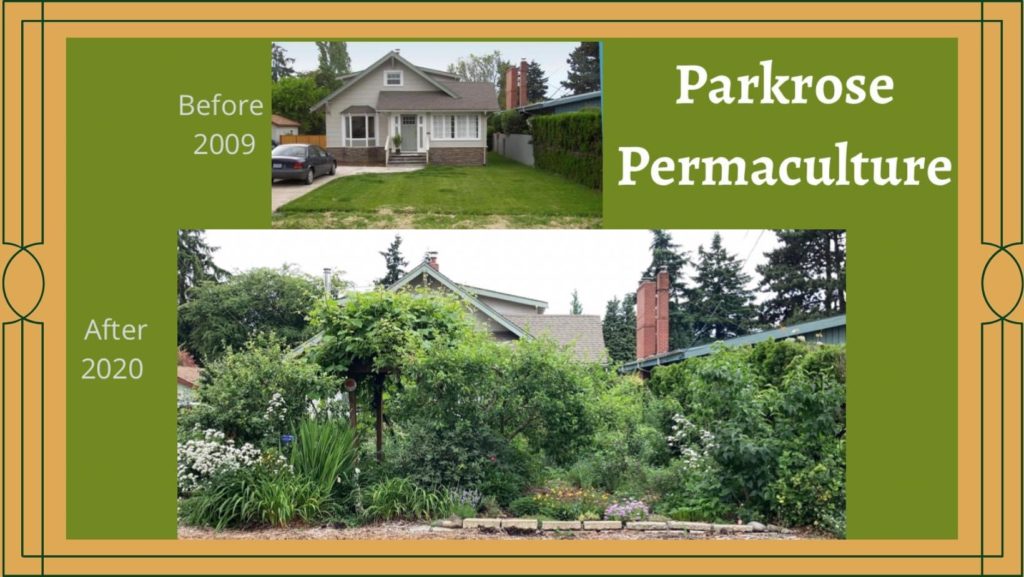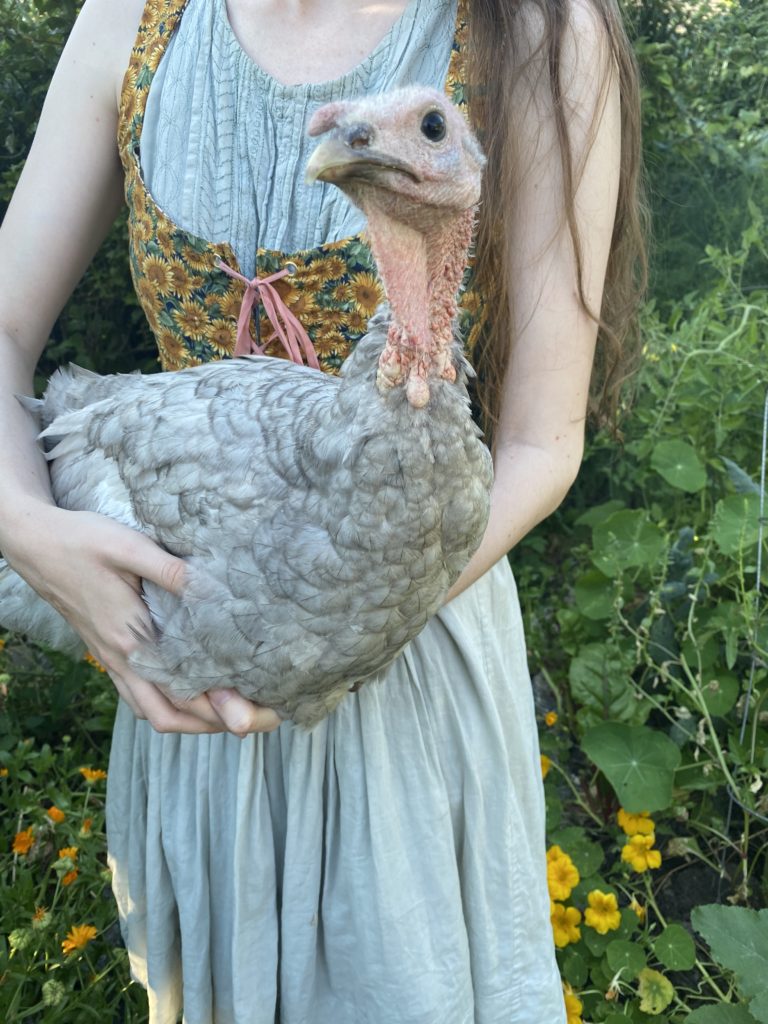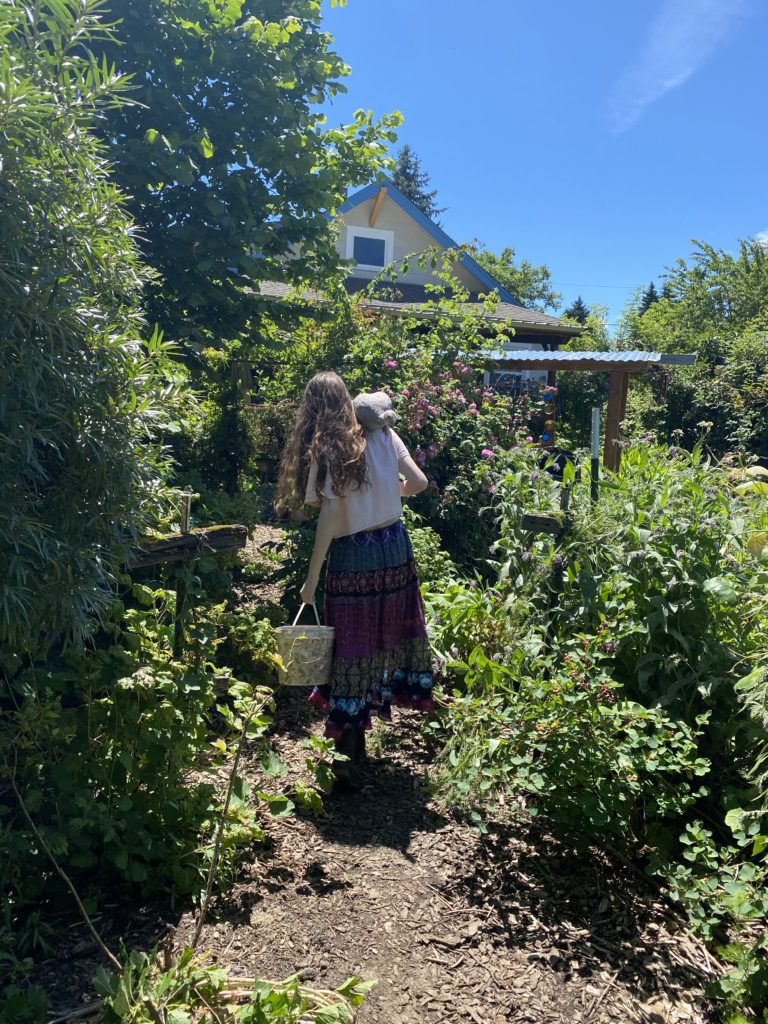
Someone Else Meme’d My Garden. It Went Viral.
I did not intend to reboot my blog after a several year absence with a post like this. But life is full of surprises. Some welcome, and some not. It’s how we respond and adapt that makes all the difference.
This week, a documentary film company made a meme of my 14 year-old permaculture garden in Portland, Oregon, USA, using “before” and “after” images, taken more than a decade apart. It immediately went viral and was shared thousands of times across multiple social media sites.
I didn’t make this meme, and had no control of what happened to it when it was set adrift in the swirling garbage patch that is the internet. That being said, watching the descending swarm of commentors attacking a garden I have poured my heart and soul and sweat and energy into for almost a decade and a half felt like watching my baby be thrown to the wolves.

Strangers Know Your Garden Best, and They’ll Make Sure You Know It
In a matter of hours, I’d been bombarded by comments sprinkled around social media as this meme gets shared over and over:
-interested folks asking how they can learn about my garden
-other gardeners sharing their gardens which look similar
-total strangers boldly declaring the images were faked or that based on ONE picture, they were sure my garden must be overrun with snakes and mosquitoes and my water bill must be astronomical
– and hundreds of insults and offensive comments. “Looks like a foreclosure.” “I’d move if this was my neighbor.” “What a mess.” “She wouldn’t know a pretty garden if it bit her in the ass.” “Looks like shit.”
As a small-time YouTuber, but dedicated garden educator whose real life is lived in blissful anonymity, I’m not accustomed to being pelted with disgraceful behavior like this from hundreds of total strangers. Performative cruelty lobbed straight at me and my home is not a daily occurence in my life. Needless to say, it’s been a rough couple of days.

July 2022.
The Problem is the Solution
My heart feels a bit beat up, and my idealistic belief in humanity shaken a bit, but I wouldn’t be a permaculturist if I didn’t choose to see this experience as an option to design for a better world. In permaculture we have a saying, “The problem is the solution.” This simple phrase means that hidden in the problem are the keys to designing solutions that heal. When we break apart and examine the problem, when we reframe the “problem” as an opportunity to observe and learn, we can begin to understand and craft solutions. Pain, hardship, failure all can lead us toward solutions if we let them.
Let’s start with reframing. I don’t have a “slugs are eating my greens” problem. I have an “abundance of duck food” solution. Similarly, I don’t have a “windy spot where every plant gets windburn” problem. I have a “chance to design a windbreak and create shelter” opportunity.

So, what is the solution in this situation? As I kept sifting through the comments, two areas for improvement rose to the forefront for me.
The Solution is People Care
1. What can be learned when folks feel entitled to weaponize their loneliness, anger, bitterness and denigrate a stranger and her work in public? What can we do to help improve our People Care when we interact with each other?
As the parent of 4 kids, I see the solution in our youth: in the ways they’re normalizing therapy, working on healthy communication and empathy. They’re learning to set boundaries. They actively work on healing from their trauma. They’re growing into the kinds of adults who can make a better future.
Those of us who have positive relationships with kids can help encourage the permaculture ethic of People Care and promote a culture of nontoxic and empathetic interaction. You don’t have to be a parent to work on your own issues and help instill non-toxic masculinity, strong boundary setting, and compassionate communicate in kids. In fact, doing so helps you heal from the trauma we hope to never strap our kids with in the first place.
We have an opportunity here to be better people, and do better by each other going forward. When we heal the ways we think about and relate to other human beings, we are on the road to creating resilient communities.
Shifting Our Expectations of Front Yard Gardens
2. Why is it that the dominant (particularly American) mindset is that a lawn with a row of boxwoods is “pretty” and “tidy” and “good”, and a vibrant, productive garden that creates habitat for wildlife, and food and resilience for the family who lives there is seen as “ugly” and “messy” and “trashy”? We’ve been so indoctrinated we have lost sight of what truly diverse and thriving gardens look like, and boring, resource-heavy lawns have been normalized. The solution is to retrain our eyes,, our hearts, our cultural norms.
Those of us who already garden this way, should do it proudly and work to shift the culture and our expectations to see permaculture systems for what they are: a way to improve the lives of the folks who live there and increase resilience and biodiversity. We have an opportunity here to educate and a chance to expand our view of beauty so that we can become resilient people in an increasingly unstable world.
Am I saying I expect everyone to like my way of gardening? No. Am I expecting every unique individual to love my lush, abundant permaculture garden when they’ve been conditioned their whole lives to see flat grass and shapeless blobs of ornamental shrubs as beautiful? Not by any means. In fact, permaculture is site-specific design. Every garden is tailored to the needs of the gardener and her land and climate. So, I don’t expect anyone’s garden to look just like mine.
But I do hope we can learn to do better by each other and by the planet. We are better than the worst of these comments. These folks who took their time and their energy to behave in public with performative cruelty toward a stranger not only show the rest of us how not to be, but they themselves have the opportunity to do better going forward.

I don’t think I could have made it more than 20 years doing permaculture in late-stage capitalism, a warming climate, and a divisive culture if I wasn’t an idealist. I couldn’t do what I do if I didn’t eternally hope for the best for people and the planet. I’m glad to be back to blogging, and while this isn’t quite the topic I had intended to relaunch my blog, I’ll take it and learn the lessons along the way.
I’ll be posting regularly here while I continue to make YouTube videos and work on writing my book. Lots more to come on permaculture design, practical resilient gardening, and community connection.
